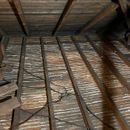Re-insulating old home
I am in the middle of renovating the living room/dining room of my 100+ year old house after removing a condemned chimney that was between both rooms. Currently the old false ceiling and crumbing plaster ceiling above it have been removed, along with the exterior and interior walls for both rooms (which after the chimney removal is now essentially one big room).
Because of this I’ve decided to remove the old dirty and damaged fiberglass insulation that the previous homeowner had just thrown into the attic in no particular order (having piles 5 feet high in some areas, and nothing in others). Also there was no insulation behind the exterior walls in both rooms.
I live in climate zone 7, in a very wet climate. I’m currently learning towards using mineral wool for a few reasons.
– Being an older home with an older roof I can’t guarantee the attic is 100% water tight, and I’ve read that mineral wool will not degrade if it gets wet.
– The other half of the house still has a false ceiling below the original plaster ceiling(which I can see is also crumbling), so a couple years down the road if I want to renovate those rooms and gain some more ceiling height by removing the false ceiling, I’d rather the insulation stay in place when removing the original plaster ceiling.
– For the interior walls I want to put in some for its noise cancelling properties
– Exterior walls are only 2×4 so I will get a higher R value with mineral wool vs. fiberglass.
I understand there is probably more than one right way to do this, but looking at all the alternatives, I still feel like mineral wool is the best bet for a DIYer. I have included a picture of the attic with the original plaster ceiling on the other side of the house.
I appreciate any advice/responses, thanks!
GBA Detail Library
A collection of one thousand construction details organized by climate and house part










Replies
You can get high-density R15 fiberglass batts, but I prefer mineral wool and think it is a superior product. Mineral wool also has the advantage of being pretty much self supporting which makes installation quite a bit easier.
I see what appears to be ye olde “type R” wire in that pic. Type R is a cotton or rayon serve (braided covering) over natural rubber insulation. Over time, the rubber gets hard and brittle and then cracks if you look at it funny. Any water getting onto the wire after it cracks can be a big problem. I strongly recommend you replace ALL of this wire that you can as you progress on your renovation project. When you have walls and ceilings open it’s not difficult to do rewiring work, and the old metal boxes have standard size knockouts that modern cable clamps will fit in just fine.
In your attic, go with blown cellulose insulation, but AIR SEAL things first. Do a good check for water leaks and repair any that you find. Insulation is not the only thing that can have problems if it gets wet — the framing doesn’t like to be wet either, and you don’t want to have mold problems.
For your interior walls, use the thinner “fire and sound” version of mineral wool. Note that real wet plaster walls are already quite a bit better than standard 1/2” drywall in terms of sound reduction, so the additional sound reduction you get from adding mineral wool won’t be as noticeable as it is when added to a home with drywall walls.
Regarding the exterior walls, what kind of exterior siding do you have? In many older structures, it’s really important to think about how things are going to dry when adding insulation.
Bill
Bill,
Thanks for the reply. I do plan on re-wiring all of that wiring during this project while it is exposed.
As for the blown in insulation, if cellulose is available in my region I will definitely see if I can get it. If it's not I may have to go with blown in fiberglass instead. But I will make sure to air seal before doing either. To clarify about the "non watertight attic" I don't currently see any active leaks, but since we live in a very wet climate I just wanted to pick the insulation type that would stand up to moisture the best.
The exterior siding is stucco. I definitely want to insulate the exterior walls, but am worried about the possibility of moister damage. Hoping to be able to insulate while keeping the moisture under control.